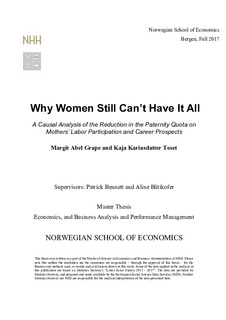Why women still can’t have it all : a causal analysis of the reduction in the paternity quota on mothers’ labor participation and career prospects
Master thesis
Permanent lenke
http://hdl.handle.net/11250/2487866Utgivelsesdato
2017Metadata
Vis full innførselSamlinger
- Master Thesis [4372]
Sammendrag
The Norwegian paternity quota was reduced from 14 to 10 weeks in 2014. This resulted in an
immediate fall in the average length of fathers’ parental leave. In this paper, we investigate
what effect this has had on mothers’ labor participation and career prospects. We utilize data
from the Norwegian Labor Force Survey to investigate labor market outcomes in the shortand
medium-term.
Previous research has found that the introduction and increase of a paternity quota has had
ambiguous effects. While some studies find that the introduction had positive effects on
equality among parents and on children’s performance, other find no significant effects.
Using a differences-in-differences analysis, we find significant, negative causal effects of the
reduction of the Norwegian paternity quota. In the short-term we find that reducing the
paternity quota has led to a decline in mothers’ work hours by 9.1 hours per week, and that the
share of women attending seminars declines by 20.2 percentage points. In the medium-term,
we find that the share of employed mothers decreases by 9.5 percentage points and that
mothers work 21.1 hours less per week. We also find that the share of mothers attending
seminars drops by 25.5 percentage points. We are unable to determine whether the reduction
of the paternity quota has had an effect on the share of women holding leadership positions or
on planned work hours. These results suggest that reducing the paternity quota has had severe
effects on mothers’ labor participation and career prospects, resulting in a weakened position
in the workplace. Several robustness checks strengthen the validity of our findings. However,
the magnitude of the estimates is at times unreasonably large, which may be explained by the
relatively small sample examined.
